What is Brand Identity?
Brand identity is a set of brand associations that the brand strategist aspires to create or maintain. This is one of the four pillars of creating strong brands. Each actively managed brand needs a brand identity – a vision of how the brand should be perceived by its target audience. The brand identity guides and inspires the brand-building program. If the brand identity is confused or ambiguous, there is little chance that effective brand building will occur. In fundamental sense, the brand identity represents what the organization wants the brand to stand for. (Aaker, David and Joachimsthaler, Eric. 2000. Brand Leadership)
Brand Identity as the visible elements of a brand (such as colour, design, logotype, name and symbol) that together identify and distinguish the brand in the customers’ mind.’ (BusinessDictionary.com)
What is Brand Image?
The impression in the consumers’ mind of a brand’s total personality (real and imaginary qualities and shortcomings). Brand image is developed over time through advertising campaigns with a consistent theme, and is authenticated through the consumers’ direct experience. (BusinessDictionary.com)
Brand Image is a unique set of associations in the minds of customers concerning what a brand stands for and the implied promises the brand makes. (Aaker, David and Joachimsthaler, Eric. 2000. Brand Leadership)
Brand image is the current view of the customers about a brand. It can be defined as a unique bundle of associations within the minds of target customers. It signifies what the brand presently stands for.” (Management study guide, MSG 2013)
What are the differences between Brand Identity and Brand Image?
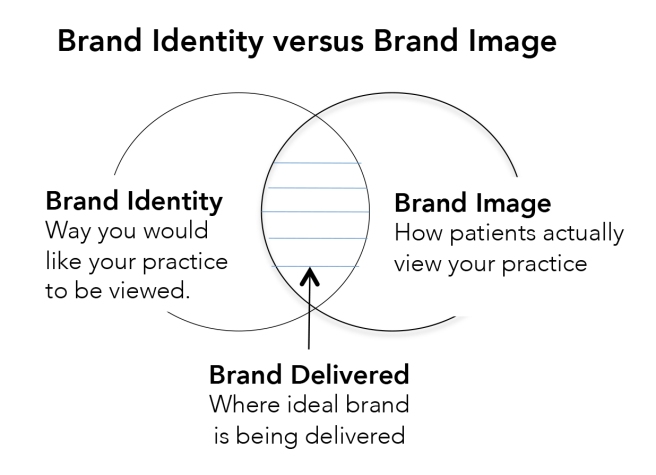
The very first and the most important difference comes from the question: Who does the perceiving – the brand or the customer? Since, the Brand Identity is what does the company want to be, then it is obvious, that brand identity is created by a brand itself. And the Brand Image is how people see the brand, so that is created by the consumer.
Brand Identity should help establish a relationship between the brand
and the customer by generating a value proposition involving functional, emotional or self-expressive benefit.”(Aaker, David and Joachimsthaler, Eric. 2000. Brand Leadership)
The Brand Image is constructed based on all sources and formed automatically; the brand builder should keep in mind that the brand image can’t be created. All in all consumers are not only purchasing the product but also the image. (MSG, 2013)
 (MSG)
(MSG)
What is the relationship between the Brand Image and the Brand Identity?
The relationship between Brand Identity and Brand Image is clearly shown on the picture below.
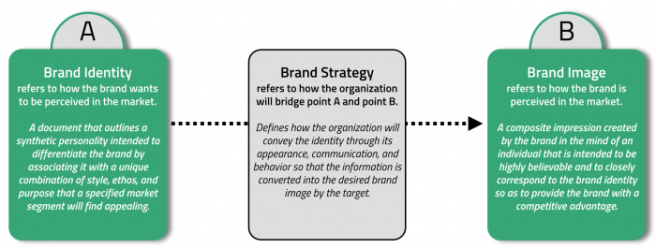
How does Brand Image affect sales?
Video from Investopedia explaining how do brand image and identity affect seles
The relationship between brand Image and Sales is found to be statistically significant. This finding is consistent with the expectation stating that if the perception of brand image is congruent with the consumer’s actual, ideal, social, image then the brand will be purchased.
Brand Identity Models
Brand Identity Planning Model, Aaker
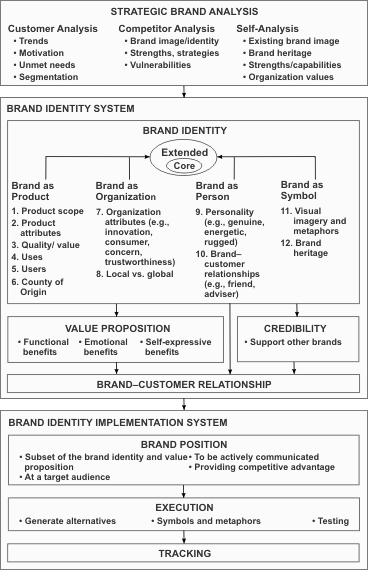
This was developed by David A Aaker, leading brand theorist, in his 1996 book Building Strong Brands. Aaker developed a planning model which outlines four dimensions of brand identity:
Brand as product
can be a single product, or set of products, which will affect the type of associations of the brand that customers experience. For customers, the attributes directly related to the purchase or use of a product can be both functional benefits and emotional benefits. Examples may be Kleenex tissues, or Band Aid, or Gillette razors. A product-related attribute can create a value proposition by offering extras like features or services. Aaker argues, however, that the goal of linking a brand with a product is for customers to remember the brand when they have a need that can be met by the product’s attributes.
Brand as an organization
focuses on organizational attributes such as, for example, innovation, quality, and safety, that are created by people, culture, values, and programmes within the company. Aaker states that organizational attributes are more enduring and resistant to competitors than product attributes. Examples may be IBM, Kodak, and Exxon.
Brand as a person
where the brand is perceived as having a personal dimension, with a unique personality similar to an individual. Aaker cites three ways a brand personality can create a stronger brand: a) a vehicle for customers to express their own personalities; b) forming the basis of a relationship between customers and the brand; and c) helping to communicate a product or service attribute in a personal way. An example may be Tiger Woods exemplifying mastery, Mercedes exemplifying elegant status and accomplishment, Apple exemplifying innovation, or Nike conveying energy and determination to succeed.
Brand as a symbol
Aaker describes this dimension as three types of symbols: a) visual imagery, b) metaphors, and c) the brand heritage. A memorable symbol can provide cohesion and structure to a brand identity and make it much easier to gain recognition and recall. Its presence can be a key ingredient of brand development and its absence can be a substantial handicap. Elevating symbols to the status of being part of the identity reflects their potential power. Examples could be the Olympic rings for a movement or where a symbol epitomizes the company, such as the Ronald McDonald clown for McDonald’s, the Jolly Green Giant, or the meerkats in Comparethemarket.com
The purpose of the brand identity planning system is to use the different brand elements and patterns that can help enrich and differentiate a brand identity. Aaker summarized his Brand Identity System as a model.
Thomas Gad, 4D Model
4 dimensions model, created by Thomas Gad suggests that building a brand in the consumers mind always seems to fall into four different dimensions: spiritual, functional, social and mental.

Functional dimension – benefits of the brand (product/service)
Social dimension – what others think of an individual
Mental dimension – what individuals think of themselves
Spiritual dimension – ( idealistic dimension)
The 4D’s model is a way to present brand in the four areas. As Gad formulate it, a brand is not a chameleon, it can- not adapt to all of the interest groups but instead the aim is to it create a well-defined, distinct brand.
Keller’s Brand Equity Model
Keller created a brand equity pyramid that also shows stages of brand development and branding objectives at each stage. According to customer based brand equity model, building a strong brand involves 4 stages of brand development (left in the figure), each stage involves its own building blogs (one level of the pyramid) and each stage has their own brand objective (right in the figure).
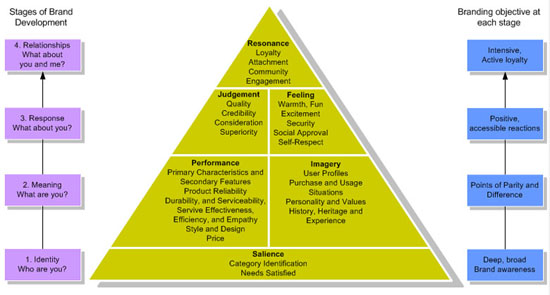
The first stage is the brand identity. The goal of the first stage is to create deep, broad brand awareness (in customers’ minds). This is done by identifying the brand with customers and associating the brand in customer’s minds with a specific product class or customer need. The first block of the pyramid, salience, relates to building the brand identity. Brand salience is about brand awareness and the basic functions of the brand. The consumers need to understand what needs the brand is meant to fulfil and into what category or part of a certain industry the brand belongs into.
The second stage is the brand meaning. It is done by establishing a brand meaning in the minds of customers by strategically linking a host of tangible and intangible brand associations with certain properties. Brand performance is about how the product or service aims to meet the customers more functional needs.
The third stage, the brand responses, identifies what consumers think or feel about a brand. The objective is to provoke proper customer responses to its brand identification and brand meaning. Those customer responses should be positive, accessible reactions build with judgements and feelings.
The final stage is the brand relationships where the brand response will be used to create an intense active loyalty relationship between customers and the brand. Brand resonance refers to that relationship and to the extent to which consumers feel they are in harmony with the brand. This can happen only if consumers are on sync first with the
other building blocks of the brand pyramid. Brand resonance consists of loyalty (how many times the product or service have been purchased), attachment (the attitude that brand is beyond good), community (social phenomenon where customer feels a con- nection with the brand) and engagement (customers willing to invest more resources (money, time, energy and so on) then required during the purchase of a product or consumption of a service.
Kapferer’s Brand Identity Prism
Kapferer represents brand identity as a six-sided prism.
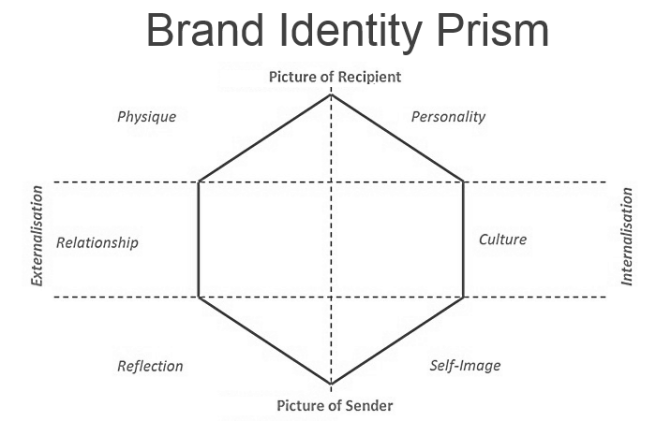
The six aspects are divided into two dimensions:
- Sender vs. Receiver
A well-presented brand has to be seen as person (sender) and also as the stereotypical user (receiver)
- Externalisation vs. Internalisation
A brand has social aspect that define its external expression and the aspects that are incorporated in the brand itself.
Aspects of Brand Identity Prism:
- Physique is a set of the brand’s physical features, which are evoked in people’s minds when the brand name is mentioned. Kapferer states that this aspect has to be considered the basis of the brand.
- Personality is the brand’s character. This can be realized by using a specific style of writing, using specific design features or using specific colour schemes. Also a person can be used to vitalize a brand.
- Culture is the system of values and basic principles on which a brand has to base its behaviour (products and communication). Many associations in this area are linked to the country of origin; Coca-Cola appeals to American values, Mercedes-Benz to German ones and Citroën to French ones.
- A brand can symbolize a certain relationship between people. Relationship aspect requires a brand manager to express the relationship his/her brand stands for. For example, Lexus differentiates itself from BMW by giving its customers the red carpet treatment.
- Reflection (of the consumer) makes reference to the stereotypical user of the brand and is the source for identification. When thinking in terms of reflection, in the case of Coca-Cola you could describe the consumer base as15 to18 year olds (with values such as fun, sporty and friendship), while the actual target group of this brand is far broader.
- Self-image is kind of a mirror the target group holds up to itself. A Porsche driver who thinks others will think he is rich because he can afford such a flash car. Research has shown that Lacoste users see themselves as members of a sporty club, even if they do not actively play any sports.
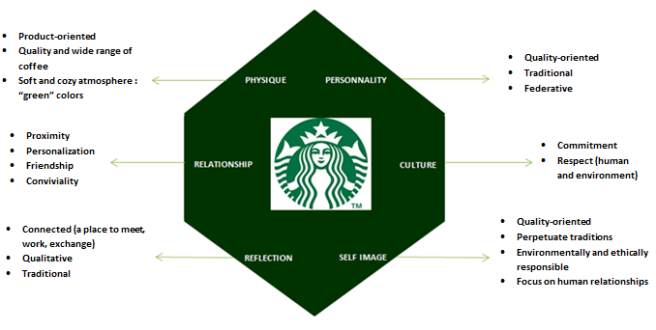
Brand Identity Elements
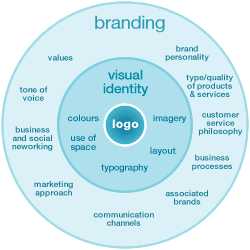
Essential elements to a comprehensive Brand Identity.
- Logo
A logo is a graphic symbol, whereas a wordmark or logotype is just the words of your company or product name set in a specific, fixed way. Your logo or logotype is the core of your brand identity.
It can be a difficult to determine whether or not you need a symbol (a traditional logo) or just a logotype. Some organizations choose a only wordmark because they are simpler design projects that generally cost less. Another factor is whether or not a memorable symbol can be designed that will show how your business is unique. A well-crafted wordmark can convey a sense of professionalism without trying to visualize your brand. There are many examples of brands with strong wordmarks include: Coca-Cola, CNN, Mobil, and FedEx.
The words that make up the name should be professionally designed and typeset—this is true if they are stand alone or beside a symbol that is part of the logo.
Good Logo Examples:
Top 50 Most Iconic Logos at all time
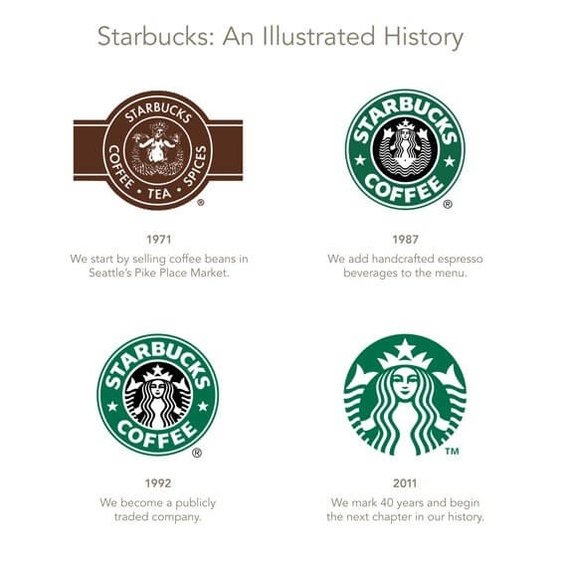
Bad Logo examples:
Brazilian Institute of Oriental Studies
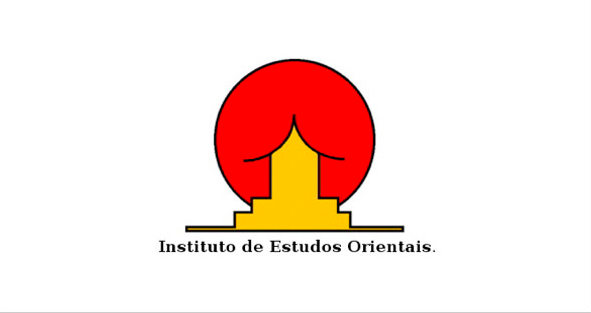
2. Key Colour
A corporate color palette is usually defined by the colors in a logo. Often these are one or two colors only, although some are more complex. 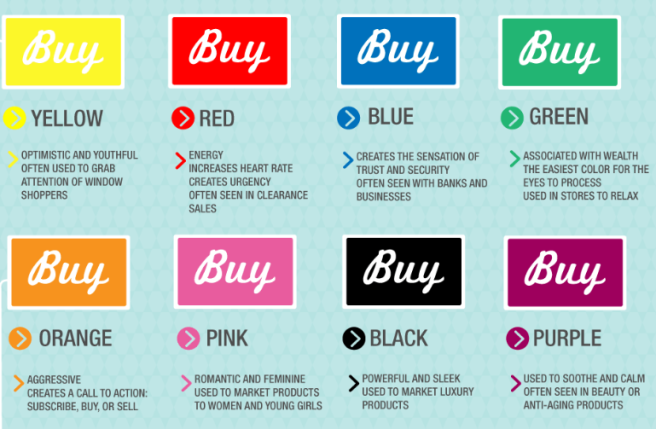
Good examples of Colour Selection:
10 Beautiful Website Colour Palettes
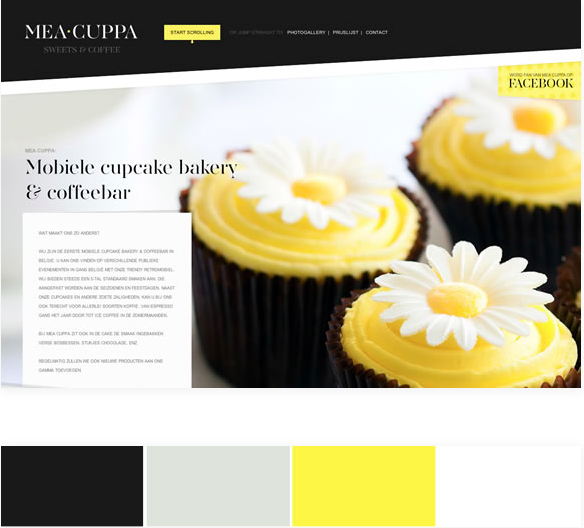
Bad Example of Colour Selection:

3. Taglines (Slogan)
- Good Tagline Example:

REFERENCES:
- Aaker, David 2011. Building Strong Brands. Simon & Schuster. London.
- Aaker, David and Joachimsthaler, Eric. 2000. Brand Leadership. The Free Press
- Gad, Tomas 2001. 4-D Branding. Cracking the Corporate Code of the Network Economy. Financial Times. Prentice Hall. London.
- Kapferer, Jean-Noël. 2008. The New Strategic Brand Management: Creating and Sustaining Brand Equity Long Term. Kogan Page. London.
- Keller, Kevin Lane 2013. Strategic Brand Management: Building, Measuring, and Managing Brand Equity. Global Edition. Fourth edition. Pearson Education. Upper Saddle River.
- Business Dictionary.com
- LinkedIn.com
- Investopedia.com
- Management Study Guide.com
- CreativeBloq.com
